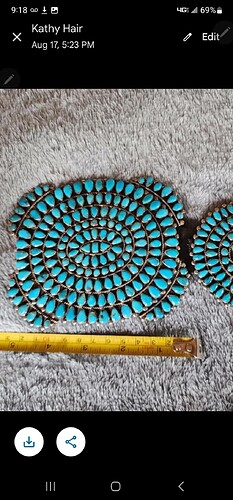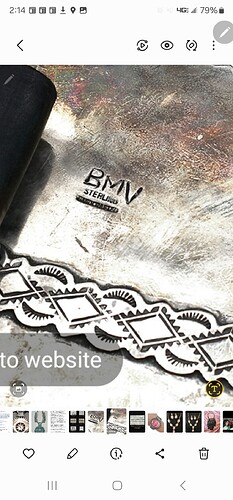I have been trying to figure out who made my cluster belt. My friends mother in law had a trading post in New Mexico where this belt was acquired 40 to 50 years ago. There is no hallmark but i was able to find a matching belt sold out of Scottsdale years ago that has a hallmark BMV which i cannot find in any listing. Here are pictures of my belt followed by the one that I found with the hallmark. I would appreciate any help that could be given.
@KMAungst Welcome! Your belt is stunning! I’m not familiar with that hallmark, but will check in a B Hougart hallmark book of mine. There are many knowledgeable folks here so hopefully someone may be able to provide more info.
@KMAungst Sorry, I didn’t locate the “BMV” hallmark in either my book or an online hallmarks identification web site.
It is a beautiful piece, looks like good turquoise and it has some age. Not really able to get a close up look of the piece. I do find it interesting that the style of the piece, the style of the block letter hallmark resemble the work of Victor Moses Begay. I shared this link of an older piece of his Vintage signed Victor Moses Begay VMB Navajo Silver/Turquoise Belt Buckle | #220615153
Hi KMAungst. Lovely belt. I would call this belt “Native Style”. A US manufacturer named David Freeland used to produce hand made Zuni style pettit point, needle point, and cluster work jewelry out of the Philippines. Some of Freeland’s pieces were absolutely magnificent.
My brother and I first encountered this jewelry at the Denver Gift show in 1980 or 81, where Dave Freeland’s son, Dave Jr was offering similar belts to wholesalers at the show. We spent quite a bit of time with Dave Jr, looking at the pieces he was offering and had a chance to take a good look at the workmanship close-up. We were astounded at the quality, and at the amount of merchandise he had.
The way the stones are set and polished in the pieces is very distinctive in that the final polish on the template cut treated turquoise stones wasn’t done until the stones were set. It was done this way so that their finishers could polish the silver and stones at the same time, saving a great deal of production time.
Looking at the wear on the bezels on this belt, it looks to me as if this is exactly the way the stones in this belt were finished.
Another item of interest is the “handcrafted” stamp on the back of one of pieces. I’ve never seen a Native made piece Zuni or Navajo with a “handcrafted” stamp on it. Virtually everything marked that way comes from production shops seeking to avoid going afoul of the Indian Arts and Crafts Act. Altogether these belts look to me like the same belts the Freelands were making in the Philippines.
moved here to continue



